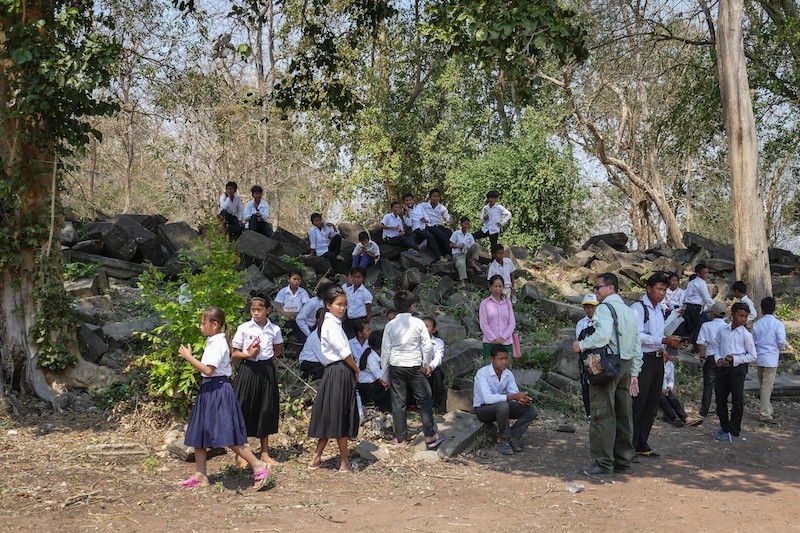For years, archaeologists excavating pre-Angkorian sites in Banteay Meanchey province unsuccessfully attempted to stop the looting of the area’s temples and buried treasures.
Heritage Watch, a group created to protect the country’s archaeological and historical sites, determined that education was the remedy. So they trained villagers and monks living near the sites, as well as commune and community leaders, government officials and teachers.

But the looting continued.
The group then realized that by the time people reached adulthood, “it’s really almost too late” to influence their actions, said Joyce Clark, who heads the Heritage Watch board. “Adult behavior may change, of course, but old habits do not fade quickly.”
So they changed their tactics and focus. The Heritage for Kids Project was born, and schoolchildren became their new secret weapon.
On a recent Saturday morning, after classes finished for the day, fifth- and sixth-grade students from Banteay Chhmar Primary School made their way to the nearby Angkorian monument for which their school is named. The youngsters sat on the scattered stones of a 1,000-year-old wall and waited for the lecture with archaeologists and heritage experts to begin.
Such outings, hosted by experts who make the three-hour trip from Siem Reap province or travel from across the nearby border with Thailand, take place twice a month during the school year, said Un Moninita, an archaeologist and executive director of Heritage Watch.
Children are “a blank canvas” ready to discover the world, Mr. Moninita said. “They are the key source and, if they get an education on heritage protection, when they grow up, their hearts will be filled with love for their heritage and the archaeological sites in their home villages. And we hope they will be key to stopping the looting at heritage sites and temples.”
Beginning last year with fifth-graders, the program now involves 175 students between the ages of 10 and 15. Their school sits across the road from the Banteay Chhmar monument, which was expanded during the reign of King Jayavarman VII in the late 12th century, and added to the World Heritage Site tentative list in 1992.
Dougald O’Reilly, who excavated pre-Angkorian sites in the region in the early 2000s, founded Heritage Watch with the hope of stopping the looting, Ms. Clark said.
The organization conducted training programs for adults in areas of Banteay Meanchey where graves had been found.
“Looting continued…especially along the Thai border,” Ms. Clark said.
“These considerations were what made us rethink the approach to heritage training and be bold enough to attack the problem with the young ones,” she said. “Through them, we reach their parents and a larger number of people, and villages become aware of the problem of selling grave goods whenever they are plowed up.”
Turning to the next generation is an approach that Cambodian and Thai researchers from the Living Angkor Road Project have been using since the mid-2000s.
As part of their study of the Angkorian road that connected Thailand and Laos with what is now the Angkor Archaeological Park in Siem Reap, they have run awareness and oral history programs for secondary school students who live in heritage site communities.
They have also brought Cambodian students to sites in Thailand, and Thai students to sites in Cambodia, said Surat Lertlum, director of the Cultural Relationship Study of Mainland Southeast Asia Research Center in Thailand. He manages the project with Im Sokrithy, deputy director of the Angkor International Center for Research and Documentation at the Apsara Authority, the government agency that manages the Angkor park.
“On both sides, Cambodia and Thailand, we are so proud that we have been able to do that,” Mr. Sokrithy said last week.
While those in the region have not forgotten the conflicts between Cambodia and Thailand over issues such as ownership of Preah Vihear temple, young people on both sides of the border are discovering that they have a common heritage, he said.
“Something new is happening for the future,” he said.
Since Heritage Watch started its program, the Thai-Cambodian project has expanded its scope to primary schools, Mr. Sokrithy said.
The program at Banteay Chhmar has been successful in making students proud of their heritage, according to Mr. Moninita of Heritage Watch, and there is hope that the Ministry of Education will include heritage education programs in the curriculum of schools near historical sites.
Then, Mr. Moninita said, “the mindset of loving one’s heritage and preserving sites and monuments will be set from childhood.”




